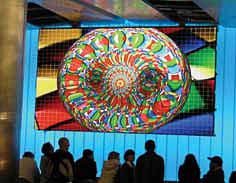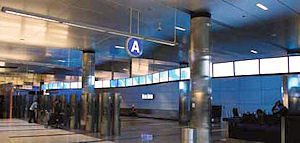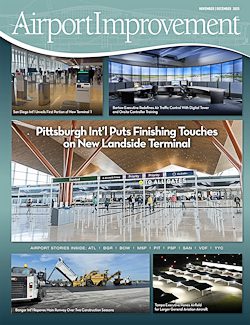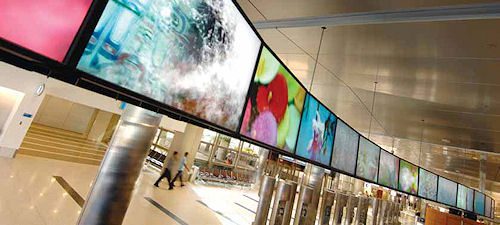 |
|
Facts & Figures Project: Digital Art Project Location: Los Angeles International Airport Tom Bradley International Terminal Value: $6 million Owner: Los Angeles World Airports Engineering & Design: AECOM Audio/Visual Design: Holonyne Corporation Installation Contractor: Sasco Electric Computer Servers/Networks: Green Hippo Ltd. Pre-Visualization System: Miranda Technologies LED Wall: Barco Touchscreen Control System: Crestron Electronics Digital Monitors: NEC Technologies Visual Systems Division Benefits: Improved aesthetics and visitor entertainment |
“It’s a nice tie-in to Los Angeles,” says Sarah Cifarelli, manager of Los Angeles World Airports’ (LAWA’s) art program. “Travelers don’t mistake they are anywhere else but the land of culture, media and film.”
The project satisfies the Los Angeles Public Percent for Art Program, which requires city departments and private developers to put 1% of construction costs toward public artwork. LAWA officials chose digital art because they felt it best represented the area’s claims to fame.
According to Cifarelli, the modern medium is also particularly apropos for airline audiences. “Video art is not like a painting that you can see as you walk by,” she explains. “It requires a little more attention and commitment on the viewer’s behalf. This is the perfect medium for people who have the time to take in the video art and let it wash over them.”
The Wow Project includes three hours of video imagery designed to provide an engaging way to spend time at the airport. Comfortable seating and access to nearby concessions add to the work’s setting. Audio/visual consultant Jon Stolzberg (Jon 9 in his professional circle), equates the installation’s surroundings to a fabulous living room that further enhances the experience.
“People in airline terminals are waiting for friends and family to arrive or to make connections,” explains the owner of Holonyne Corporation. “Often, they are tired and stressed. If the environment is inviting and engaging through the presentation of art, it has the power to transform traveler experiences in positive and significant ways.”
Casting Call
While video art was considered a perfect fit for the airport, it became a production challenge that tested the entire creative team – even Stolzberg, who has been developing video walls since the 1980s. “I’ve been on challenging projects before,” he relates, “but this one, because of its size, the number of people involved and the fact that you had a major construction site in the middle of an operating terminal, tested everyone.”
Stolzberg’s previous clients include the Guggenheim Museum and Cirque du Soleil.
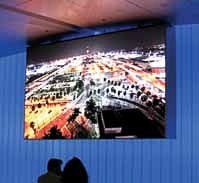 |
LAWA partnered with the Los Angeles Department of Cultural Affairs to fulfill its public art obligations and issued a nationwide Request For Qualifications to more than 2,000 emerging, mid-career and seasoned artists. A panel of art professionals reviewed the submissions and prequalified 19 artists from a field of 46 applicants. They then asked prequalified artists to submit creative proposals for approval, which 17 of the 19 artists did.
|
Digital artwork from 17 visual artists conveys abstract themes such as motion and the passage of time. |
Electronic Canvases
Artists came with files as large as 1 terabyte and a host of questions. Did they need to create 29 separate videos or one video to stretch over the entire Filmstrip? Did just one file or 25 separate files play on the video wall? Ted Wheaton, design project manager for project engineer/design firm AECOM, soon realized the project required Holonyne’s assistance in system design.
Stolzberg quickly scrapped the standard digital sign technology that was originally planned in favor of more sophisticated art-making tools. At the same time, LAWA added a large Barco LED video wall with programmable LED lighting in the programming studio and a dozen 65-inch plasma displays in the Federal Inspection Service Arrivals area.
|
The work titled”Filmstrip” includes 58 video screens that snake in back-to-back pairs across the terminal’s lobby. |
The initial plan designated two days per artist for programming, but Stolzberg soon found file sizes dictated much longer sessions, as artists were asked to work at the highest resolution possible. Some of the files for Filmstrip, for instance, were 720 pixels high by 37,120 pixels wide. “That’s like taking 15 feature films and stacking them together in terms of digital film resolution,” he explains.
Stolzberg scheduled artists for 10-hour programming sessions and imported their work prior to the meetings. During the sessions, he helped program various events, such as which files were going to which screens, how long they were going to play and whether there would be special effects in terms of speed, color, brightness or contrast. Stolzberg uploaded the artists’ final programming into a playlist with 10 to 12 separate art projects. The playlists were then compiled into “daylists,” with different programming for each day of the week.
Production Difficulties
Debugging was necessary during the networking phase of the project. The system incorporates 60 networked servers from Green Hippo Ltd. and a pre-visualization system from Miranda Technologies connected to a Cisco 10G network switch. Because the computers and servers are very different from typical computing systems, they required special networking configurations.
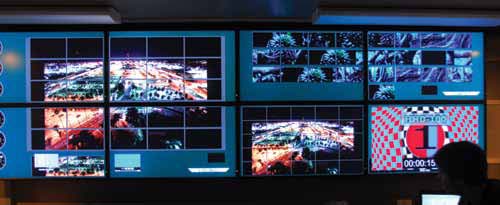 |
Getting video signals from Point A to Point B was another head-scratcher. The airport provided a small office, formerly used by Mexicana Airlines, for the installation’s equipment room and programming studio. Because tugs drive luggage on top of the space, the office is surrounded by concrete. “We had to figure out how to get power and data conduit in and out of the room and install cooling equipment,” recalls Wheaton. “Everything was a challenge.”
Driving HD signals from the control room at the terminal’s north end to video walls 500 feet away was a particular dilemma, notes Stolzberg. “We ended up employing the same technology used in broadcast TV studios and converting signals to HD-SDI to travel over coaxial cable,” he explains. “This eliminated the need for expensive DVI extenders and fiber optics.”
The Closing Act
As AECOM turns the project over to LAWA, Wheaton is confident airport IT professionals can keep the system running well into the future. Touchscreen software from Crestron Electronics automates many features and allows personnel with limited training to perform basic operations.
“While there’s a lot of complexity to the system, it’s been designed with management layers in order to become a manageable part of the airport infrastructure,” Stolzberg notes. For instance, basic system operators can use menus to tweak timelines, load files and turn the system on and off. System administrators perform full-scale programming, while maintenance personnel keep technology functioning properly.
And the Award Goes to…
According to Stolzberg, Los Angeles International’s brightly lit, multi-colored displays are the first of their kind in any U.S. airport – and one of the largest installations he has ever worked on. “People have put digital art into airports before, but I don’t think anyone has ever done anything on this scale before,” he says.
A project of such magnitude required an enormous amount of collaboration, reflects Cifarelli. Wheaton designed the data server room, IT infrastructure and control studio; AECOM’s Aaron Adilman worked with suppliers on specifications, delivery and major component commissioning; Stolzberg designed the system and teamed with Green Hippo to configure and integrate media servers; and Cifarelli coordinated the artists.
“Everybody brought their own experiences and viewpoints to the table to make this work,” explains Cifarelli. “This wasn’t a project where one person had all the answers.”
The culmination of the team’s work is a colorful and engaging display that will put the ‘Wow’ in Tom Bradley International Terminal for many years to come.

